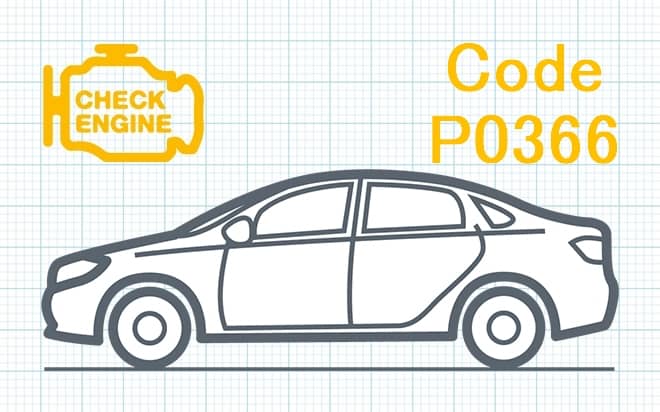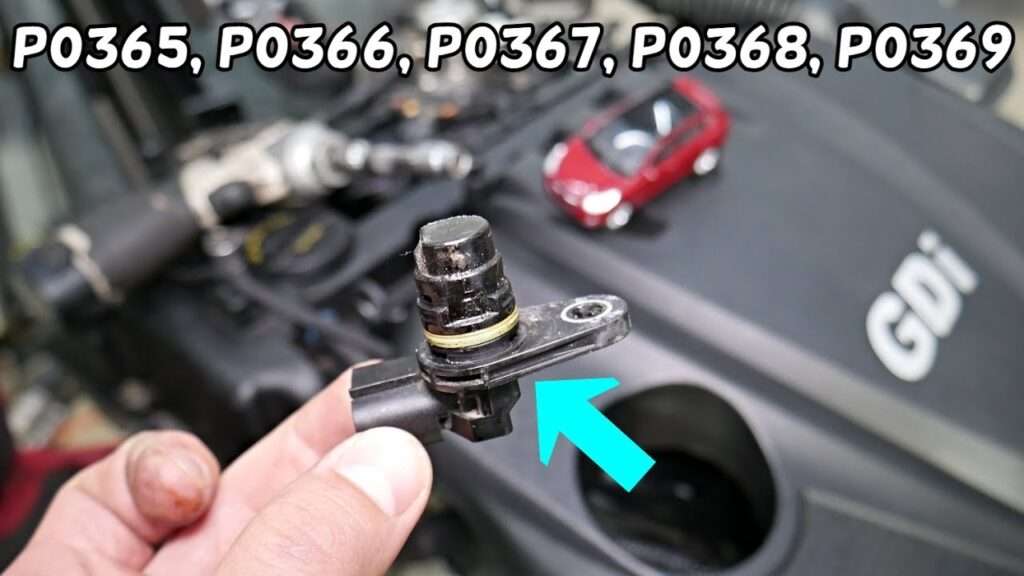
P0366 Camshaft Position Sensor Circuit Out of Performance Range (Sensor "B", Bank 1)
Content
P0951 – OBD-II Trouble Code Technical Description
Trouble code P0366 indicates that the vehicle's PCM has detected an abnormal voltage in the camshaft position sensor “B” circuit (bank 1).
What does the fault code mean P0366?
Trouble code P0366 indicates a problem with the camshaft position sensor or the signal coming from it (sensor "B", bank 1). This code means that the engine control module (ECM) has detected that the camshaft position sensor circuit voltage has deviated too much from the manufacturer's specified voltage.

Possible reasons
Some possible reasons for the P0366 trouble code:
- Camshaft Position (CMP) Sensor Malfunction: The sensor may be damaged, dirty, or have poor contact, causing its signal to be read incorrectly.
- Wiring and Connectors: The wiring connecting the camshaft position sensor to the engine control module (ECM) may have opens, shorts, or poor connections.
- Problems with the rotor or steering wheel: Wear or damage to the rotor or steering wheel may cause the sensor to not read the signal correctly.
- Malfunctions in the engine control module (ECM): It is rare, but possible, that the engine control module (ECM) itself may have problems, causing signals from the sensor to be misinterpreted.
- Problems with the power or ground circuit: Malfunctions in the power or ground circuit can also cause P0366.
- Problems with other ignition or engine control components: For example, faults in the ignition system such as spark plugs, ignition coils or control valves can cause the sensor or control unit to not operate properly.
It is important to carry out detailed diagnostics to accurately determine and eliminate the cause of the P0366 code.
What are the symptoms of a fault code? P0366?
Symptoms for trouble code P0366 may vary depending on the specific cause of the problem and the condition of other engine components. Some common symptoms that may be experienced:
- Check Engine: The appearance of the “Check Engine” light on the dashboard is one of the most common symptoms of the P0366 code.
- Unstable engine performance: If the camshaft position sensor is faulty, engine instability may occur. This may result in shaking, rough operation, or loss of power.
- Ignition misfires: A faulty camshaft position sensor can cause a misfire, which can cause jerking or loss of power when accelerating.
- Poor performance and fuel efficiency: Incorrect camshaft position reading may affect the operation of the fuel injection and ignition system, which in turn may reduce engine efficiency and increase fuel consumption.
- Unexpected engine stops: In some cases, especially if the problem is severe, the engine may stall while driving or refuse to start.
It is important to remember that symptoms can occur to varying degrees and depend on the specific conditions and characteristics of the vehicle. If you notice any of these symptoms, it is recommended that you immediately contact a qualified technician to diagnose and repair the problem.
How to diagnose a fault code P0366?
Diagnosing trouble code P0366 involves several steps to identify the specific cause of the problem:
- Checking Error Codes: Use the diagnostic scanner to read all trouble codes, including P0366. This will help determine if there are other problems that may be related to a faulty camshaft position sensor.
- Visual inspection of the CMP sensor: Check the camshaft position (CMP) sensor for damage, corrosion, or signs of oil leakage. Make sure it is properly secured and free of deposits.
- Checking wiring and connectors: Inspect the wiring connecting the CMP sensor to the engine control module (ECM) for opens, shorts, or corrosion. Check the connectors for damage and make sure there is good contact.
- Sensor resistance measurement: Use a multimeter to measure the resistance of the CMP sensor according to the manufacturer's specifications. Incorrect resistance may indicate a faulty sensor.
- Checking the sensor signal: Using an oscilloscope or diagnostic scanner, check the signal from the CMP sensor to the ECM. Make sure the signal is stable and within expected values.
- Additional tests and diagnostics: If necessary, perform additional tests such as power and ground circuit checks, ignition system operation checks, and other tests to rule out other potential causes of the error.
- Replacing the sensor or repairing the wiring: If the CMP sensor or wiring is found to be faulty, replace the sensor or repair the wiring according to the diagnostic results.
After diagnosing and fixing the problem, it is advisable to clear the error code using a diagnostic scanner and conduct a test drive to verify that the problem has been successfully resolved. If the error code appears again, you may need more in-depth diagnosis or professional help.
Diagnostic errors
When diagnosing the P0366 trouble code, various errors or problems may occur that can make it difficult or slow to determine the cause of the problem:
- Insufficient skills and experience: Diagnostics of electronic engine systems requires certain skills and knowledge. Insufficient experience of the mechanic or technicians may lead to incorrect interpretation of the results and incorrect determination of the cause of the malfunction.
- Lack of special equipmentNote: Correctly diagnosing some problems, such as measuring sensor resistance or analyzing a signal with an oscilloscope, may require specialized equipment that may not be available to non-professionals.
- Incorrect reason exclusion: When diagnosing a P0366 code, it can be tempting to focus only on the camshaft position (CMP) sensor and its surroundings, while ignoring other possible causes such as problems with the wiring, control unit, or other system components.
- Damage to components during diagnostics: Incorrect diagnostic methods or unskilled repair attempts can result in additional damage to components, increasing repair costs and time.
- Unavailability of spare parts: Some causes of P0366 may require replacement of the CMP sensor or other components, and unavailability may slow down the repair process.
It is important to be aware of these potential problems and, if necessary, contact a professional mechanic or service center for diagnosis and repair. This will help avoid additional problems and provide more accurate and efficient troubleshooting.
How serious is the fault code? P0366?
Trouble code P0366 is serious because it indicates a problem with the camshaft position (CMP) sensor. Incorrect operation of this sensor can result in engine roughness, loss of power, increased fuel consumption, and other serious problems with engine performance and efficiency.
While in some cases the problem can be resolved quite simply by replacing the sensor or correcting the wiring, in other cases the cause may be more complex and require more extensive intervention or replacement of other engine components.
It is important to resolve the cause of the P0366 code as soon as possible to avoid further damage and ensure normal engine operation. Problems with the camshaft position sensor can lead to serious consequences, including loss of vehicle control and even accidents in some cases.
Therefore, it is recommended that you contact a qualified mechanic or service center for diagnosis and repair if you encounter trouble code P0366. Only an experienced specialist will be able to correctly determine the cause and fix the problem, ensuring the safety and reliability of your car.
What repair will help eliminate the code? P0366?
Troubleshooting DTC P0366 typically involves the following steps:
- Replacing the Camshaft Position (CMP) Sensor: If the camshaft position sensor is identified as the source of the problem, it should be replaced with a new one. However, you must ensure that the new sensor meets the requirements of your vehicle manufacturer.
- Checking and replacing wiring and connectors: The wiring connecting the camshaft position sensor to the engine control module (ECM) can also be a source of problems. Check wiring for breaks, shorts or other damage. If necessary, replace damaged wires or connectors.
- Checking and servicing the rotor and steering wheel: The rotor and steering wheel that the CMP sensor interacts with must be in good condition. Check them for wear, damage or dirt. If problems are found, they should be replaced or serviced.
- Checking the Engine Control Module (ECM): In rare cases, the problem may be related to the engine control module (ECM) itself. Check it for any malfunctions or damage. If problems are found with the ECM, it should be replaced or repaired.
- Additional diagnostics and maintenance: In some cases, the cause of the P0366 code may be more complex and require additional diagnostics or service to other engine components such as the ignition system, fuel injection system, and others. Make sure all components are working properly.
After completing these steps, it is recommended to take a test drive to verify that the problem has been successfully resolved. If DTC P0366 no longer appears, the problem has been successfully resolved. If the problem persists, it is recommended that you contact a professional mechanic or service center for further diagnosis and repair.
P0366 – Brand-specific information
Trouble code P0366 can have different meanings depending on the specific make of the car, several examples with their meanings:
- Chevrolet: P0366 – Camshaft position sensor B – open circuit.
- Ford: P0366 – Camshaft Position (CMP) Sensor – No Signal.
- Toyota: P0366 – Camshaft sensor B – signal ratio incorrect.
- Honda (Honda): P0366 – Camshaft sensor “B” – signal high.
- Nissan (Nissan): P0366 – Camshaft position sensor B – open circuit.
- BMW: P0366 – Camshaft Position Sensor “B” – Signal High.
These are just a few examples, and the meaning of the P0366 code may vary depending on the specific model and year of the vehicle. For accurate information, consult the vehicle manufacturer's documentation or a qualified service center.
